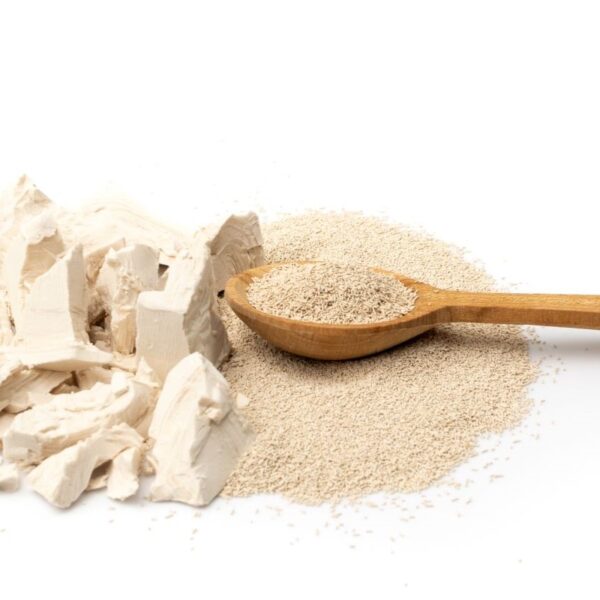Succinic acid – also known as butanedionic acid – is a natural acid found in many types of living organisms that produce it through biosynthesis. It occurs in various vegetables, fungi, bacteria, and yeast, which have metabolic pathways that can produce succinic acid as part of their normal physiological processes. Succinic acid is produced commercially through chemical synthesis and biological fermentation and is used in the food industry as a multi-purpose additive.
What is Succinic Acid?
Succinic acid is an α,ω-dicarboxylic acid resulting from the formal oxidation of each terminal methyl group of butane to the corresponding carboxyl group. It is one of the organic acids and is an intermediate metabolite in the citric acid cycle.
Source: Wikipedia
How is Succinic Acid Produced?
While succinic acid is found in natural sources, modern commercial production is done via chemical synthesis or fermentation.
| Natural Sources | Historically, obtained from amber by distillation |
| Chemical Synthesis | Obtained by catalytic hydrogenation of maleic acid or its anhydride |
| Fermentative Synthesis | Fermentatively produced by genetically modified E. coli or S. cerevisiae |
Both chemical synthesis and biological fermentation methods are used to produce succinic acid for food and beverage products, and the choice of the production method depends on factors such as cost, scalability, and environmental considerations. Biological fermentation is considered a more sustainable and environmentally friendly approach. However, the process requires careful optimization of fermentation conditions, including pH, temperature, nutrient availability, and oxygen levels.
Applications in the Food & Beverage Industry
Succinic acid serves several purposes in food and beverage products, including the following:
| Function | Applications |
| Acidulant | Succinic acid is an acidulant of relatively low acid strength. It is used to reduce the pH of certain foods. |
| Flavoring Agent | Succinic acid imparts a slightly salty and bitter taste along with sourness. It has a slow taste buildup and lingering taste. |
| Preservative | Succinic acid exhibits strong antibacterial activity and a pH-lowering effect, which helps improve the shelf life of food products. |
| Flavor Enhancer | Succinic acid can be used to improve the flavor profile of food products. |
Product Examples
Succinic acid is used in a wide variety of foods and beverages, as described in the table below:
| Category | Examples |
| Beverages | Carbonated Beverages, Still Beverages, Fruit Juices |
| Confectionery | Candies, Chewing Gums, Soft Chews, Hard Boiled Candies |
| Convenience Foods | Powdered Beverages, Powder Mixes |
| Fruit Preparations and Preserves | Jams, Jellies, Squash, Marmalades |
| Bakery | Cake, Cookies, Snack Bars, Pies |
| Desserts | Gelled Desserts, Cream-Based Desserts |
Properties of Succinic Acid
| Molar Mass | 118.09 g/mol |
| Melting Point | 188°C |
| Specific gravity (25 °C) | 1.572 |
| Appearance | White crystals or powder |
| Solubility (Water @ 20 °C) | 80 g/L |
| pKa | 4.16 |
| pH (1mM aqueous) | 3.65 |
| Refractive Index | 1.450 |
Typical Formulations
Meat Flavoring
Here is an example of a meat flavoring formulation table with succinic acid, along with the composition of ingredients:
| Ingredient | Composition |
| Casein Protein Hydrolysate | 1.0 g |
| Monosodium Glutamate | 1.0 g |
| Inosine-S ‘-monophosphate | 0.6 g |
| Succinic Acid | 0.15 g |
| Lactic Acid | 3.0 g |
Source: Google Patents
Beverage Mix
Here is an example of a beverage mix formulation table with succinic acid, along with the composition of ingredients:
| Ingredient | Composition |
| Citric Acid (Anhydrous) | 3.6 g |
| Succinic Acid | 1.2 g |
| Phosphoric Acid | 1.4 g |
| Calcium Carbonate | 0.4 g |
| Magnesium Carbonate | 1.5 g |
| Potassium Carbonate | 2.2 g |
| Sucrose | 100 g |
| Yellow Color | 0.001 g |
| Orange Flavor | 2.0 g |
| Potassium Benzoate Solution (2.5%) | 20 g |
| Water | Adjust to reach 1000 g |
Source: Google Patents
Succinic Acid Formulation Considerations
| Physical Forms | Crystals, Powder |
| Stability | Thermal Decomposition: 235 ℃Easily absorbs moisture |
| Sensory Attributes | Odor: Odorless Taste: Tart taste with slow taste build-up, while pure aqueous solution is slightly bitter Color: White to off-white |
| Dosage | 0.1-2% or more (depends on end application) |
| Interaction with Other Components | Interacts with strong bases and strong oxidizing agents |
Acetic acid is another organic acid that is commonly found in various food products.
Safety & Regulatory Considerations
| FDA Information | The FDA affirms the status of the food additive succinic acid as Generally Regarded as Safe (GRAS). It approves the use of succinic acid as a flavor enhancer and pH control agent. |
| EU Information | Succinic acid is approved by the EU as a food additive with number E 363. |
Health Effects of Succinic Acid
- Anti-Inflammatory Activity — Succinic acid has been reported to possess cardioprotective, antithrombotic, and anti-inflammatory activity.
- Antimicrobial Activity — Succinic acid can be used in the food industry to control bacterial contamination by S. aureus and P. fluorescens.
Identification Numbers
| Chemical Name | Butanedioic acid |
| CAS Number | 110-15-6 |
| EC Number | 203-740-4 |
| INS No. (Food Additive) | INS 363 |
| FEMA Number | 4719 |
Acceptable Limits or Maximum Usage
The maximum usage level of succinic acid in food products as per the FDA is as follows:
| Category | Usage Level |
| Condiments and Relishes | 0.084% |
| Meat Products | 0.0061% |
The maximum usage level of succinic acid in food products as per the EU Regulation on Food Additives is as follows:
| Category | Usage Level |
| Soups and Broths | 5000 mg/kg |
| Flavored Fermented Milk Products, Including Heat-Treated Products | 6000 mg/kg |
| Flavored Drinks | 3000 mg/kg |
| Other | 3000 mg/kg |
| Desserts | 6000 mg/kg |
Fun Facts About Succinic Acid
- Succinic acid is also known as the “Spirit of Amber.” When it was first discovered, it was extracted from amber by pulverizing and distilling it using a sand bath. It was primarily used externally for rheumatic aches and pains.
- Succinic acid is biodegradable, making it environmentally friendly and reducing its impact on ecosystems.




